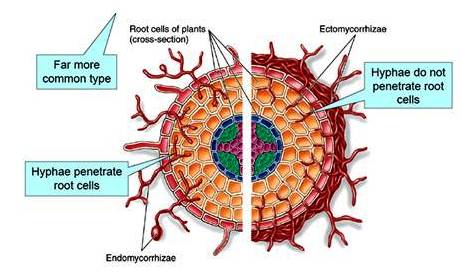मिट्टी कें पोषक तत्व निर्धारण में माइकोराइजा कवक का योगदान
Arbuscular mycorrhizal fungi (AMF) are obligate symbionts with higher plants. Mycorrhiza is the association between fungi and the roots of higher plants and microorganisms and higher plants. On a global scale, between 86% and 94% of plants are mycorrhizal.
Mycorrhizal associations are mutualistic, neutral, or parasitic depending on the circumstances although mutualism is the dominant type.Associations between arbuscular mycorrhizal fungi (AMF) and plant roots are usually non-specific in terms of the fungus-plant pairings that are compatible.
A positive effect of mycorrhizalinoculation on growth of plants in metal contaminated soils. Arbuscularmycorrhizas have the ability to alleviate many anthropogenic stresses, including effects of metals and polychlorinated aliphatic and phenolic pollutants. Remediation of soils contaminated with toxic pollutants using specific combinations of plants with mycorrhizal fungi deserves increased emphasis.
Groups of mycorrhizas
The two main types of mycorrhiza are ecto and endo mycorrhizas, differ in their structure and physiological relationships with host plant. Mycorrhiza fungi frequently stimulate plants to reduce root biomass and simultaneously expanding nutrient uptake capacity by extending far beyond root surfaces and proliferating in soil pores that are too small for root hairs to enter.
Two mycorrhizal groups of fungal mycelium are:
a) Endo mycorrhizas. The fungi live inside the cortical cells of the roots and also grow intercellularly known to occur in wide spread cultivated soil.
b) Ecto mycorrhizas. This group of mycorrhiza occurs mainly on roots of woody plants and only occasionally on herbaceous and graminaceous perennial plants. Temperate tree species like beech, oak, spruce and pine cannot survive without ectomycorrhiza.
They form a sheath or mantle of fungal mycelium over the surface of fine roots. The hyphae penetrate into the intercellular spaces of the root cortex and it extends outward into the soil.

Ecto and Endo mycorrhiza
Role of AM fungi in the C, Nand P cycle
The biotrophic nature of AM fungi, acceleration of organic matter decomposition has been linked to microorganisms lead to an increased release of CO2 from the soil through microbial respiration, but this may be counteracted by the increased photosynthetic activity and therefore CO2 uptake by plants.
Substantial part of the photosynthates from the host plant are invested in the formation of AM fungal biomass, both in terms of root colonization and mycelial network in the soil, AM fungi have been suggested to be important in carbon sequestration in the soil. The importance of AM fungi on the N cycle in agroecosystems, transporting N as NH4+ to the host plant.
The importance of AM fungi in N biogeochemical processes reduce N loss from the soil in terms of leaching and denitrification .
AM fungi transports immobile P from the soil to the host plant.Low soil P conditions often limit plant growth and reproduction, impacting agricultural and natural plant communities worldwide,under these conditions, infection of plant roots by vesicular-arbuscularmycorrhizal (VAM) fungi is especially beneficial.
Mycorrhizal plants generally have a higher P status than nonmycorrhizal plants.Decrease in soil P, mycorrhizal infection often increases vegetative growth in the host plant.Mycorrhizal infection will improve other factors (e.g., flower production, pollen production, and pollinator visitation) that influence fitness through the male function under natural field conditions.
Functions of Mycorrhizae
The relationship between the fungus and a plant can obviously have a great impact on the environment. Plantshaving this association with mycorrhizal fungi will have a greater chance in inhabiting environmental stress.
Nutrient Acquisition
The function of mycorrhizae is to exchange nutrients between their surroundings and their host plant. The increase in root surface area and the protection they offer to the plant's roots, the fungus is able to acquire a lot of nutrients for its host.
Mycorrhizae are able to uptake water, inorganic phosphorus, mineral or organic nitrogen, and amino acids through specialized transporters located on their membrane. The water and nutrients are acquired; they can then be transferred to the host, who in return supplies carbon.
Aiding in Agriculture
Mycorrhizal relationships help to increase plant growth beneficial in agricultural fields. This symbiotic relationship in agricultural fields increases crop production and therefore increase infood output.
The mycorrhizal fungi aids in soil aggregation, which can increase water filtration and gas exchange within the soil. With an increase in gas exchange, the mycorrhizal fungi can aid in the aeration of agricultural fields.
Aiding in Restoration
Symbiotic relationship of fungus allows plants to be greater competitors and allow them to prosper in areas low in nutrients and water; they are very useful in restoration efforts. The partnership of mycorrhizaeincreases plant's ability to colonize an area, they would also have a greater capacity to out compete.
Beneficial effects of Mycorrizhae
- Increased overall absorption capacity of roots due to morphological and physiological changes in the plant. The increased absorption surface area, greater soil area explored, greater longevity of absorbing roots, better utilization of low-availability nutrients reducing reaction with soil colloids or leaching losses.
- Increased mobilization and transfer of nutrients from the soil to the plant.
- Increased establishment, nodulation and atmospheric nitrogen fixed capacity.
- Modification of plant pathogen relation mycorrhizae influence the colonization of roots by other microorganisms, reduce the susceptibility of roots to soil borne pathogens.
- Secretions of antibiotics and support of a community that competes or antagonizes pathogenic microorganisms, thus aiding in disease suppression.
- Increased production of plant growth hormones such as cytokines and gibberellins.
- Modification of soil plant water relations, promoting better adaptation of plant to adverse environment conditions (drought, metals).
Conclusion
AM-fungi are effective in increasing nutrient uptake, particularly phosphorus and biomass accumulation of many crops in low phosphorus soil. AM-fungi have an important role in promotion of biological and chemical properties of plants under stressed environment.
Authors:
Dr.A.G.Rajalakshmi
Senior Research Fellow
Vanavarayar Institute of agriculture, Manakkadavu, Pollachi
Email:
